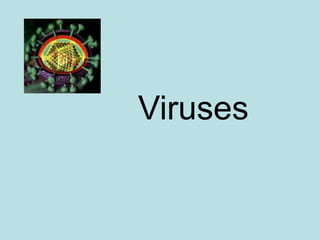
Viruses2011
- 2. Characteristics of Viruses 1. Tiny, nonliving particles a. do not respire, move, grow 2. Must reproduce inside of a host 3. Pathogens: disease-causing a. Virulence: degree of response caused in a host 4. Not given latin names a. named for disease caused, organ infected, or region first detected in
- 3. Viral Structure 1. Inner core of nucleic acid surrounded by protein coat called capsid a. head contains either DNA or RNA body
- 4. Figure 19-13 Virus Structures Section 19-3 Tobacco Mosaic T4 Bacteriophage Virus Influenza DNA RNA Virus Head RNA Capsid Capsid proteins Tail sheath Tail fiber Surface proteins Membrane envelope Go to Section:
- 5. Recognition & Attachment of Viruses 1. Virus must recognize specific receptor site on host. A. part of the virus matches site on host B. lands on host and “locks in”
- 6. 2. Attachment is specific a. virus can enter & reproduce in only a few kinds of cells Example: tobacco mosaic virus cannot affect human cells even though we are exposed to it.
- 7. There are 2 ways viruses can reproduce inside a host. 1. Lytic cycle-fast 2. Lysogenic cycle-slow
- 8. Lysogenic Cycle( virus can enter a period of inactivity before becoming lytic) STEPS 1. Attachment- virus attaches to the host cell 2. Entry- whole virus or just nucleic acid enters the cell 3. Replication- viral nucleic acid joins w/DNA of host cell. It may stay there inactive for years. Host cell continues to divide
- 9. If the cell reproduces, the viral nucleic acid is also copied so each new cell is infected. 4. the virus becomes active and enters the lytic cycle. 5. Assembly,lysis, & release- new viral nucleic acids & protein coats are assembled. The virus exits the host cell. Example- AIDS, Herpes
- 10. Figure 19-15 A Lysogenic Infection Section 19-3 Bacteriophage Bacterial DNA chromosome Bacteriophage injects Bacteriophage DNA DNA into bacterium (prophage) can exit the bacterial chromosome Lytic Lysogenic Cycle Cycle Bacteriophage enzyme lyses the Bacteriophage DNA Bacteriophage DNA forms a circle (prophage) may replicate bacterium’s cell wall, releasing with bacterium for many new bacteriophage particles that generations can attack other cells Prophage Bacteriophage proteins and Bacteriophage DNA nucleic acids assemble into inserts itself into complete bacteriophage particles bacterial chromosome Go to Section:
- 11. Common Diseases Caused by Viruses Section 19-3 Type of Virus Nucleic Acid Disease Oncogenic viruses DNA cancer Retroviruses RNA cancer, AIDS Adenoviruses DNA respiratory infections Herpesviruses DNA chickenpox Poxviruses DNA smallpox Go to Section:
- 12. Go to Section: